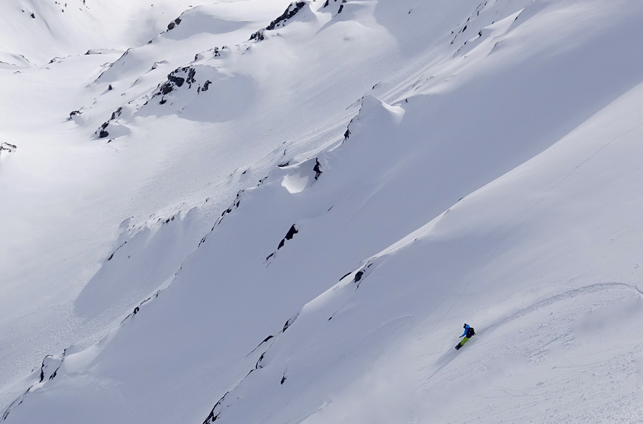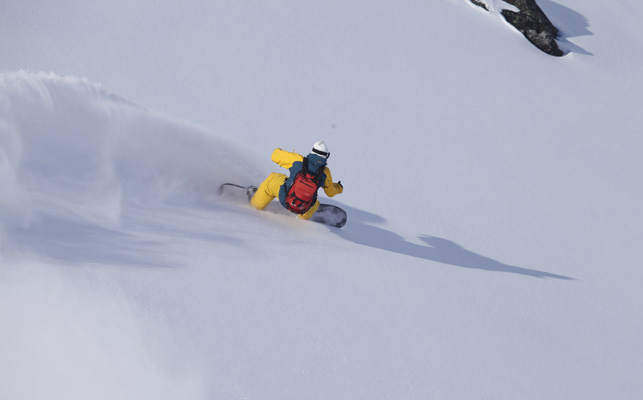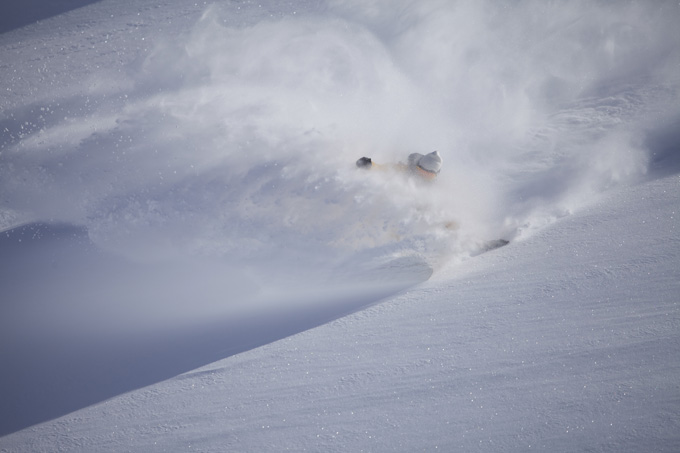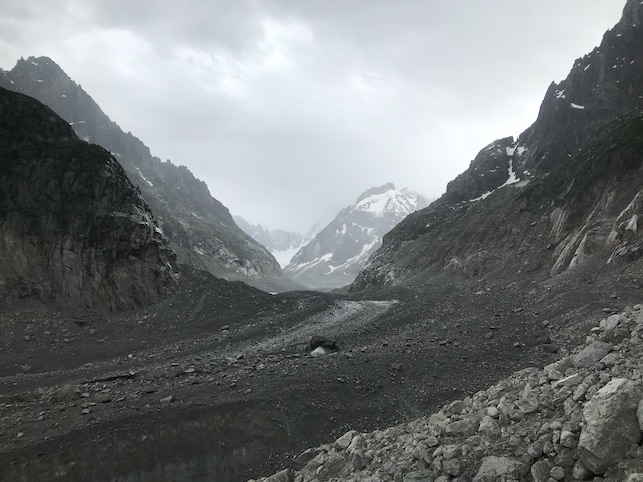
The Art of the Arc part 3 – Where mind surfing mountain becomes a reality.
Where Mind surfing mountains becomes a reality!
So you’ve got a deeper understanding of how the turn shape, your body movements and the equipment you ride are linked to line, speed and flow from ‘The Art of the Arc’ parts 1 & 2 and now you’re ready to take it to the natural terrain of the mountain.
This is where Freeriding begins and you really explore the potential of your riding.
It is about you, your skills, your influences, knowledge and the Art you want to create on the mountains natural canvas.
As we’ve already explored, in terms of technique and movements, we all need to stand, move our feet, flex and bend in a similar fashion to balance and bend the board into the turn to work with the board by design rather than force.
But here as we move onwards, away from pure technique, the individual within us can start to take over and a form of self-expression can take these natural controlling movements of riding into the unknown and beyond.
This is where your creativity comes into play, your influences are expressed and your individual style flows through.
Just as no two bodies are the same, no two people see the mountains terrain through the same eyes, no two people feel their body movements in the exact same way and no two people will ride the exact same line in the exact same way.
Where one might see banks to surf, another might see lips to launch. Where one might see arcs to make, another might see a straight line to the bottom…

In Freeriding, there are no rules beyond what feels right and brings the desired results for you, your ability and your creativity.
Of course, this doesn’t mean that you throw all the elements deemed necessary in parts 1 & 2 out the window, it purely means you take them and explore their inner workings and outer boundaries and adapt them to your own desires, your own movements, strengths and even weakness’s.
As a Freerider, your line and flow is in part governed by you, your skills and your self expression, but it is also partly governed by what the mountain deals you, the conditions on the mountain, the elements you see and your ‘read’ of the mountains terrain.
For the experienced Freerider, conditions play a massive roll in choice of Speed, line and flow.
This doesn’t mean just the ‘overall conditions’, but also the minute details that might change the working conditions of the decent, second by second as you ride it.
An experienced Freerider will be aware off and see these conditioning elements way before they drop into their chosen line.
In many cases, it is the knowledge and experience that they have gained through the years that has brought them to this line, to this terrain and has seen them make this choice at this precise time in the first place.
They may have made numerous plans and choices on their way to the mountain this very morning all with regards to the conditions in real time.
They may have studied the snowpack, noticed the wind, the temperature, the pathway of the sun, they know the aspect, the gradient and like a Surfer studying the weather charts, they know which location, which slopes, which lines should be working the best.
For most great freeride lines, it is not chance that has led the way, it is a series of observations and decisions that have been made moment by moment and this knowledge along with strong riding technique prepares the canvas of the successful Freerider.
And once here, when the decision has been made, it is this knowledge of how the mountain works that will help them ride a flowing line within the terrain and the current conditions.

A great working line, when everything comes together, is the Freeriders dream.
When the line works with the conditions and the shape of the terrain the ride really flows.
It’s like finding and placing the pieces of a jigsaw. Sometimes the pieces simply fall in to place in front of you, sometimes its a little harder to find the correct pieces and sometimes it is like you are bing thrown the pieces, catching and trying them in place as you ride.
There are many factors that make for a great decent.
Creating a flowing line within the mountains terrain is about connecting the dots and inspiring your ride within the terrain features and conditions that you see.
When the conditions are perfect and the powder lies fresh, deep and stable, all lines are good, everything works and we are all great riders.
But if the conditions are more variable, the wind and temperature has played its card and the last snowfall is days away, then experience and observation come into play and the creative pull through.
On my last course in Baqueira, Spain, we had 10cm of fresh snow blown by the wind followed by blue skies and rising temps.
A window of opportunity opened with the good visibility, but the fresh snow was shallow or scoured in most places and had been carried by the wind.
The trick was to find the lines where the snow had collected in sheltered channels on Northerly aspects where the still air would remain colder for longer whilst also watching out for dangerous terrain shapes, loaded gradients, snowpack tension and secondary exposures such as terrain traps.
To those in the know, the working lines were obvious, but I’m always amazed by how many riders are way off the mark when it comes to reading the conditions, picking their lines or choosing where to make their turns.
Its dawned on me, over the years, that what might seem obvious to those of us that live and breathe mountains is maybe not so obvious to those that don’t see the signs or know what they are looking for.
Recently on my courses, I’ve started to explore the conditions a little more with my teams, explaining what I see and what I’m looking for in terms of creating a flowing line that works with the best of the conditions available.
In turn, explaining what I see, how I read the mountain sign and how I use terrain shape to create my line has made me more aware of the creative potential in my own riding and the importance of condition awareness.
In my own riding, it is this combination of condition awareness and the inspiration of terrain shape that creates the flowing line that I will ride.
Here, beyond technique Freeriding becomes a blend of your actions, ability, experience and awareness played out within the natural theatre of the mountains.
Build you ride by starting with the most obvious, clues…
Firstly, you need to see where the good snow lies and, maybe more importantly, notice where it is not so good.
You’ll be able to carry more speed and flow in good snow, but will have to change rhythm and velocity as you hit, or preferably ‘before’ you hit, variable snow.
You’ll need to notice which way the wind has blown, has it loaded areas, has it scoured areas.
As well as changing the safety risk factor, the effect of the wind can also change greatly the feel and quality of the snow you ride.
Many times I have hiked a summit with a group of guys, only to watch them ride the wind affected crud right next to the silken powder lying in the shelter a couple of meters to the side of their line.
Snow quality is important for speed control.
You don’t want need to lose speed in an area scoured by the wind for example, better to control speed and line in a quality zone where you can ride the base of the board deep into the snowpack rather than on the hard pack where you’re balancing or bouncing on the edge.
Preferably you’ll try to make line and speed adjustments before and after this low quality section in a way that allows you to ride through it with the minimum loss of flow.
Gradient is also a big factor.
If it’s deep (and safe) even the steepest gradients can feel amazing and can be ridden at speed.

If the conditions are less good, steep gradients might need a more cautious approach.
It is obviously more difficult to lose speed on steep terrain than it is to gain speed. If you need to control speed in the Steeps, you might want to think about your line as you approach to this area.
If it’s deep then a speed check through the tail of the board might be sufficient to drop the acceleration in to the next turn.
How much we turn the board from the fall line controls our speed. In deep snow however, we can create the turn in two axis.
On firm snow, we ride into and out of the fall line in arcs drawn on the surface of the snow on the surface horizontal plane.
In deep snow we can also turn our board vertically towards the sky on the vertical axis to control speed by sinking the tail deep into the soft snow. In super deep snow, we might only need to turn vertically to control our speed, whilst riding in a straight line down the hill.
Of course, the resistance of the deeper snow has a braking effect too.
The fact that we are balancing and riding on the whole base rather than the edge also helps as we increase the volume of the running surface and the pressure we can apply to bend the board into and out of the turn.
Finally we can easily displace and compress deep soft snow, rotating the board against our direction, in a skid, without loosing control of the Arc, to control speed with out the loss of flow that this actin might have on a firmer surface.

The combination of turning on two axis, plus the added resistance on the larger planning surface and snow displacement means that in deeper snow we can physically turn less and carry more speed even in steeper terrain.
Terrain shape is my personal guide when I ride.
Terrain shape shows me and tells me everything I need to know.
It drives my safety compass, highlighting different tensions in the snowpack created by shape, gradient, wind flow and sunlight.
It highlights areas of exposure, primary and secondary and it creates my line as I mind surf between the banks, rollers, steeps and drops below me.
Terrain shape helps me build a mental image of how the ride might flow and feel. Areas where I can gain speed and lose speed due to snow quality but also exposure, gradient and the lay of the land.
Many riders make the mistake of solely looking at the fall line as their guide.
The Fall line is for sure the fastest line, but unless the conditions are perfect and you want to straight line the whole decent, you’ll have to brake from the line to control speed at some point and more often than not, speed control following the fall line is a more skidded approach that works best in deep snow.
When we use the arc of our line to control speed, we need to stop looking solely at the fall line and see the terrain from the side angle too.
When we turn in an arc across the slope, our line of travel now hits the terrain at a completely different angle from that of the fall line running straight down the hill.
I often say that, ‘we ride around the mountain, not just down the mountain’. By this I mean that we need to not look down the hill but around the hill, our line of travel needs to arc across and up into the terrain around us rather than simply following the pull of gravity always down.
A rider that sees the terrain from all angles opens the doors to an endless source of new and creative lines.
Unless the terrain is open and featureless, terrain shape can be used to help with control of speed and line in many ways.
Flatter gradients can act as speed checks before steeper areas where we can then accelerate.
Banks to the sides allow us to turn upwards to control speed without having to turn as much as we would if the terrain was flat, whilst also giving that ‘surf the wave’ feeling that I personally crave.
Knowledge, appreciation and use of terrain shape in your line is how you create flow in your ride.
Open your eyes and let the mountain guide your line, but remember to not just look down the hill, there’s a whole mountain surrounding you that waits to be ridden too.
Be creative and notice everything, ride with the mountain, not against it.
And so that is it for now.
Like I said in part 1, if you get anything from this series that makes a difference to how you ride or think about how you ride in a positive way then it has been worth it.
If you got something out of the series, then please recommend it and pass it on to others. If not, then simply keep your mouth shut and carry on doing what you’ve always done.
There is no right or wrong way to Freeride, but some ways definitely work better and have greater appeal than others.
Try to work with the natural movements of your body to create a flowing line within the natural terrain of the mountain.
What could be more simple and pure than that?
Get out, be safe, respect and create!



